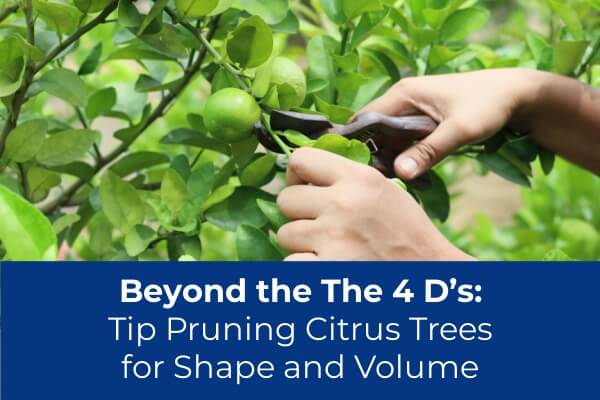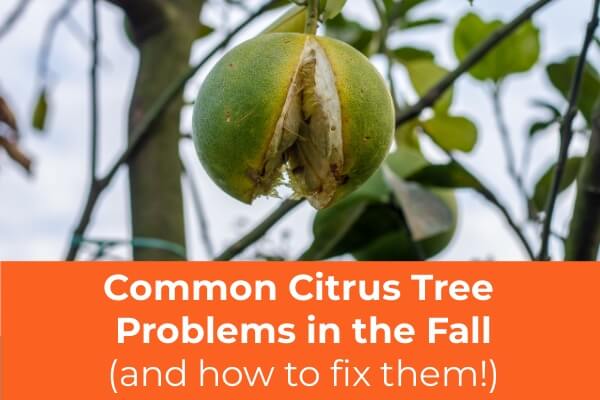Table of Contents
Beyond the The 4 D’s: Tip Pruning Citrus Trees for Shape and Volume
The Essential Guide to Pruning Citrus Trees
Pruning citrus trees is one of the best ways to keep them healthy, productive, and attractive. While citrus trees don’t require as much pruning as deciduous fruit trees, strategic trimming can enhance fruit quality, reduce pests and diseases, improve airflow, and maintain an attractive shape. But where do you start? Understanding the 4 D’s of pruning is the first step. They are the Diseased, Damaged, Dead, and Disoriented branches. Once your tree is clear of these problem branches, tip pruning citrus trees for shape and volume is the next step. Doing this can help shape your tree and encourage lush growth.
The 4 D’s of Pruning Citrus Trees
When pruning citrus trees, the first priority is removing branches that negatively affect the tree’s health and productivity. This is where the 4 D’s come in. Each category represents a type of branch that should be removed to promote better growth and fruiting.
1. Diseased Branches
Citrus trees can fall victim to a variety of fungal, bacterial, and viral diseases. Signs of disease include blackened or sunken areas, oozing sap, or leaves with yellow or brown spotting. If you notice a branch showing these symptoms, remove it immediately. Make cuts well below the affected area at a diagonal angle, and always sterilize your pruning tools with rubbing alcohol or a diluted bleach solution between trees to prevent spreading disease.
2. Damaged Branches
Branches can be damaged, cracked or broken by strong winds, heavy fruit loads, pests, or other mechanical injuries. A cracked, split, or partially broken branch won’t heal properly and can become an entry point for pests and diseases. Removing damaged branches allows the tree to direct energy toward healthy growth rather than trying to sustain an injured limb.
3. Dead Branches
Dead branches are easy to spot as they are brown, brittle, dry, and have no new growth. Sometimes, they may have peeling bark or a hollow sound when tapped. Leaving dead branches on a tree can invite wood-boring pests and fungal diseases. Cutting them off encourages fresh, healthy growth and prevents further deterioration.
4. Disoriented Branches
Disoriented branches are those growing in odd directions—such as crossing over other limbs, growing inward toward the trunk, or pointing straight up. These branches often cause congestion in the canopy, blocking sunlight and reducing airflow, which can lead to disease issues. Removing them helps open up the tree, allowing for better light penetration and air circulation.
By focusing on the 4 D’s, you create a strong, healthy structure for your citrus tree, making it easier to maintain and more productive in the long run.
Advice on Tip Pruning Citrus Trees for Shape and Volume
Once you’ve cleared out the problem branches, it’s time to shape your tree. Tip pruning, also known as soft pruning or light trimming, is an excellent way to control size, encourage bushier growth, and maintain an aesthetically pleasing shape.
What Is Tip Pruning Citrus Trees?
Tip pruning is the process of lightly trimming the ends of branches to stimulate new growth. By snipping off the growing tip of a branch, you signal the tree to produce multiple shoots below the cut, leading to a fuller, more compact canopy. This method is particularly useful for young citrus trees, as it helps establish a strong and well-balanced structure early on.
Benefits of Tip Pruning Citrus Trees
- Encourages bushy growth: Cutting branch tips stimulates lateral branching, resulting in a denser canopy.
- Enhances fruit production: More branches mean more potential fruiting sites.
- Controls tree size: Keeping the tree at a manageable height makes harvesting and maintenance easier. It is also easier to scout for pests and treat if necessary.
- Improves air circulation: A well-spaced canopy reduces the risk of fungal diseases.
A Guide to Tip Pruning Citrus Trees for Shape and Volume
Tip pruning is best done in spring when the tree is actively growing. Here’s how to do it effectively:
1. Use sharp, clean pruning shears to make precise diagonal cuts and prevent tearing.
2. Identify the branch tips that are growing too long or in an undesirable direction.
3. Make a clean cut about 1/4 inch above a leaf node or bud. This encourages new growth at that point.
4. Step back and assess as you go to ensure you’re creating a balanced shape.
5. Prune regularly throughout the spring for continuous shaping.
Additional Citrus Pruning Tips
- Avoid heavy pruning in fall and winter. New flush growing during this time can be susceptible to cold damage.
- Avoid pruning in the late summer if your area has leaf miner pests. These insects target young flush during the hottest weeks of the year, and any new flush resulting from late summer pruning is susceptible to infestation.
- Watch for water sprouts and suckers. These vigorous shoots drain energy from the tree and should be removed as soon as they appear.
- Thin out excessive growth by eliminating any crossing branches or growth directed towards the center of the tree. If your tree becomes too dense, selectively remove branches to let light and air reach the interior.
- Use proper tools. Sharp pruners are ideal for small branches, while loppers or a pruning saw may be needed for thicker limbs.
More about pruning your citrus trees:
Pruning citrus trees doesn’t have to be intimidating. By following the 4 D’s you create a healthy foundation for growth. From there, tip prune your citrus trees for shape and volume which also enhances fruit production, and keeps its size manageable. With regular maintenance, your citrus trees will reward you with beauty, abundant flowers, and delicious fruit for years to come.




